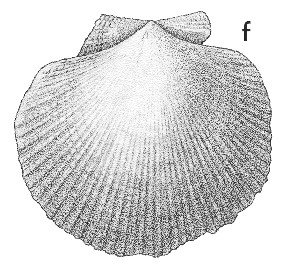
Revised descriptions of New Zealand Cenozoic Mollusca from Beu and Maxwell (1990)

 | Revised descriptions of New Zealand Cenozoic Mollusca from Beu and Maxwell (1990) | 
|
  (Pl. 10f): GS486, I40/f6467, Fishing Rock, Wharekuri, Waitaki Valley, Whaingaroan (GNS) |
Beu & Maxwell (1990): Chapter 9; p. 130; pl. 10 f.
Synonymy: Pecten uttleyi Marwick 1924e, p. 325; Serripecten (Janupecten) uttleyi
Type species of Janupecten Marwick, 1928
Classification: Pectinidae
Description: Size moderate for family (height 55-60 mm), left valve more inflated than right. Ears subequal, separated from disc by narrow channels, these much more marked in right than in left valve, and more prominent posteriorly than anteriorly. Byssal notch deep, fasciole narrow; ctenolium apparently absent. Dorsal margins of left valve ears colinear, smooth, those of right valve divergent, serrate. Radial sculpture on right valve appearing at about 20 mm from umbo, of about 50-60 low, flattened or convex costae, scaly in some specimens but almost smooth in most shells; interspaces typically somewhat wider than costae. Ears with 4 or 5 similar costae. Other sculpture of growth lines and "Camptonectes" microsculpture. Radial sculpture in left valve highly variable, almost obsolete in some shells, in others consisting of subdued costae similar to those on right valve but appearing distally. Other sculpture of very fine radial striae and fine growth lines.
Comparison: The discrepant sculpture and the presence of aural channels in both valves effectively distinguish Janupecten uttleyi from nearly all other New Zealand pectens. J. polemicus (Whaingaroan, south-west Auckland) is most similar, but has less well developed channels (particularly in the left valve) and has radial rays with little or no surface expression in the right valve. J. subteres (Duntroonian, North Otago) resembles J. polemicus in aural channel development but has right valve radial costae present only distally (only near the dorsal margins in some shells). Duplipecten waihaoensis (Pl. 5d) and D. parki have aural channels in the right valve only, and have the right valve more inflated than the left, the opposite situation to that in Janupecten. Waller (2006, p. 16) pointed out that the narrow white exterior radial bands on some specimens of Janupecten polemicus, corresponding in position to the radial costae, are formed by corrosion of an inner pale layer of chalky, unstable shell material (presumably aragonite) through the very thin outer calcitic layer. Cross sections show that the chalky material is restricted to a lenticular area beneath the rib crest, and provides a highly distinctive character to Janupecten. However, examination of Zittel's (1864) types in Vienna demonstrated that Maxwell (in Beu & Maxwell 1990, pp. 144-145) was correct to suggest that the type material of Pecten hochstetteri Zittel is the wider, Oligocene (Duntroonian) species rather than the narrower, Miocene one that has usually borne this name. The Oligocene species evidently evolved from Janupecten subteres (Duntroonian) by continued suppression of radial sculpture, so that Janupecten is a synonym of the real Lentipecten, and the Miocene taxon remains an unnamed genus and species. Waller (2006) also described remnant spine-like scales on rib sides in early Janupecten species, demonstrating that the group evolved from Serripecten, and included Janupecten (i.e., Lentipecten) in his new tribe Serripectinini.
Distribution: Runangan?, Whaingaroan; Whaingaroan, lower part of Wharekuri Greensand, "Fishing Rock", Waitaki River near Wharekuri (type) (common); ?Woodpecker Bay, North Westland (some specimens with radial costellae between costae on right valve, but otherwise similar to topotypes).
Cite this publication as: "A.G. Beu and J.I. Raine (2009). Revised
descriptions of New Zealand Cenozoic Mollusca from Beu and Maxwell (1990). GNS
Science miscellaneous series no. 27."
© GNS Science, 2009
ISBN
978-0-478-19705-1
ISSN 1177-2441
(Included with a PDF facsimile file
copy of New Zealand Geological Survey Paleontological Bulletin 58 in CD version
from: Publications Officer, GNS Science, P.O. Box 30368 Lower Hutt, New
Zealand)